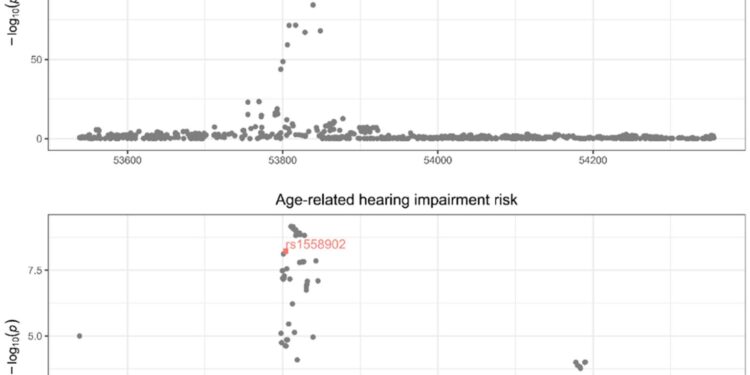Regional associations map the risk of body mass index (BMI) and age-related hearing loss (ARHI) to the FTO locus. The single nucleotide polymorphism (SNP) rs1558902 was marked in a colored square shape. Regional plots were established for associations reported in the GIANT consortium and the UK Biobank for IMC and ARHI, respectively. Credit: Scientific reports (2023). DOI: 10.1038/s41598-023-44735-x
A new study from the University of Oulu, Finland, sheds light on the complex interactions between noise exposure, hearing loss and body constitution.
Ambient noise has become a major public health problem, with prolonged exposure posing risks such as hearing loss. Observational studies have suggested a potential association between long-term exposure to traffic noise and obesity risk.
In 2019, the World Health Organization guidelines on environmental noise for the European region rated the evidence for the association between transport noise and obesity as low or very low quality and highlighted the importance of studying hearing-related outcomes associated with noise exposure.
Faced with this complex interaction, LongITools project researchers embarked on a genetically informed study led by doctoral student Yiyan He. The study aimed to untangle the causal relationship between body constitution and hearing loss, asking the question: is hearing function a key factor to consider in understanding the link between noise exposure and hearing loss? obesity ?
Using data from publicly available genome-wide association studies (GWAS) in repositories such as the UK Biobank, FinnGen and the Genetic Investigation of Anthropometric Traits (GIANT) consortium, the study focused on participants whose the average age ranges from 52 to 63 years. The results were published in Scientific reports.
The results presented in the study challenge the idea that an increase in adiposity-related measures directly leads to hearing loss. However, research has revealed a remarkable association: Age-related hearing loss could lead to lower BMI and body fat percentage in the adult population of European ancestry. This suggests a unique relationship in which age-related hearing loss may influence body weight and fat.
Lead researcher and author Yiyan He commented on the implications of the study, saying: “Our research provides evidence that older adults with hearing problems can experience weight loss and fat reduction. This poses challenges for those who suffer from hearing loss and malnutrition simultaneously. Increased nutritional support is crucial for this vulnerable group. »
More information:
Yiyan He et al, A two-way Mendelian randomization study to evaluate the relationship between body constitution and hearing loss, Scientific reports (2023). DOI: 10.1038/s41598-023-44735-x
Provided by the University of Oulu
Quote: Age-related hearing loss can lead to lower body mass index and total body fat (November 24, 2023) retrieved November 24, 2023 from
This document is subject to copyright. Apart from fair use for private study or research purposes, no part may be reproduced without written permission. The content is provided for information only.



